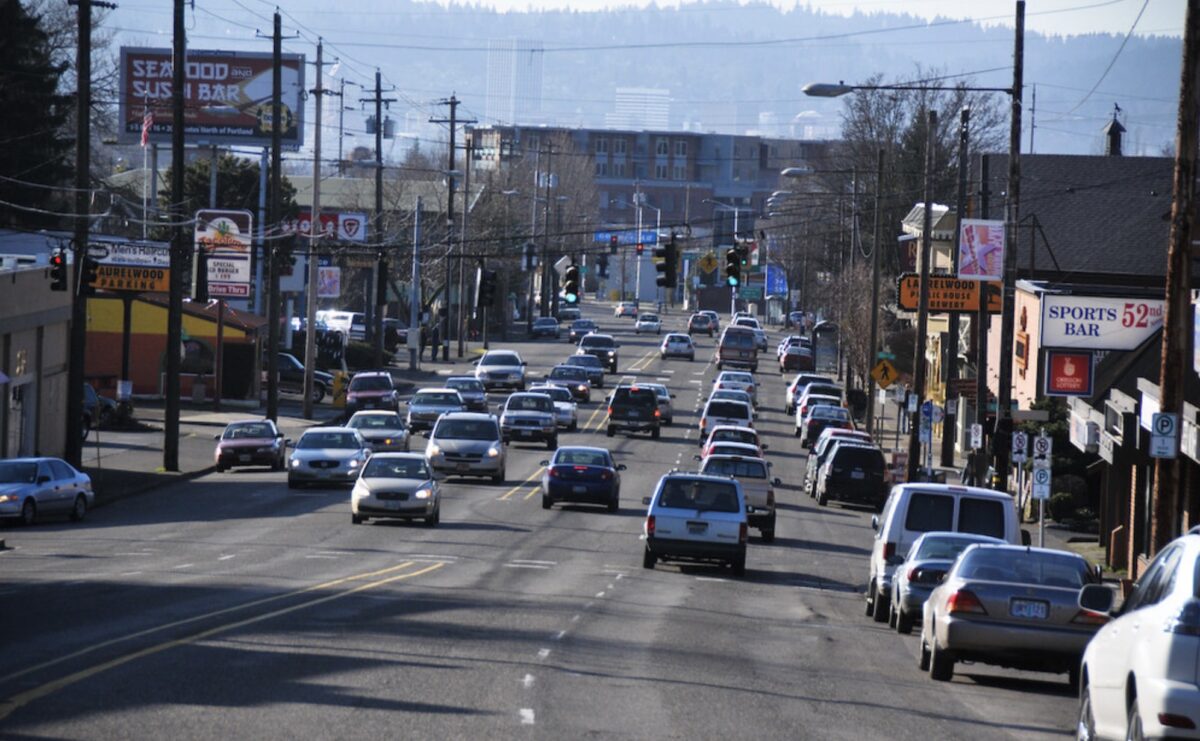
(Photos: J. Maus/BikePortland)
Few streets in Portland have as much potential as Sandy Boulevard. From the Central Eastside to the Parkrose neighborhood, this rare diagonal street cuts through our dense grid and offers quick cross-town trips and direct access to myriad destinations.

Designated as a “civic corridor” in Portland’s Comprehensive Plan and expected to see major growth in housing and jobs in future years, Sandy’s outdated design is currently not up to the task.
Sandy’s traffic lanes only safely accommodate people traveling inside metal-framed boxes with large motorized engines. That’s one reason why, like many other driving-centric arterials in Portland, Sandy has a deadly and dangerous legacy and is currently designated as a High Crash Corridor. That’s also why it was named the “Worst Street Ever” in a 2012 short film.
Despite its risks, many bike riders are devoted to it because it offers speed and convenience unmatched by neighborhood greenways.
Unlike other arterials, Sandy is owned by the City of Portland and not the State of Oregon. That means instead of sitting around and begging the Oregon Department of Transportation for updates, we can take action to make Sandy work for the road users of the future: people on bicycles, e-bikes, scooters, and all manner of personal mobility devices.
And that’s exactly what the Portland Bureau of Transportation (PBOT) wants to do.
Advertisement
“The plan will… take a multimodal lens that also considers potential for bicycle facilities along the corridor.”
At their meeting this morning, Portland City Council approved a $300,000 grant application submitted by PBOT to ODOT and the Oregon Department Land Conservation and Development. The grant would allow PBOT to move forward with the creation of a “transportation growth management” (TGM) plan for Sandy Blvd.
The project hasn’t been made public yet, but PBOT has shared an outline with BikePortland.
The working title is Sandy Boulevard Civic Corridor Plan.
If the grant comes through, PBOT planners would create a foundation for future capital projects to transition Sandy away from its, “largely auto-oriented” design (their words, not mine), “widely spaced pedestrian crossings,” and “sidewalk corridor that is disrupted in many locations at large, skewed intersections” and toward a street that will, “accommodate various modes of travel and other uses of the right-of-way.”
Here’s more about the project from PBOT (emphasis mine):
“There is no accommodation for bicycle travel along Sandy Blvd and very few transit priority treatments for the frequent Line 12 bus. Overall, Sandy Blvd is one of the streets in the City of Portland that faces the most conflicting demands for various uses, given that it classified as a “Major” street for every mode (pedestrian, bicycle, transit, freight, traffic, and emergency response) and also has a Civic Main Street classification (suggesting need for curb zone access) in our Transportation System Plan. Sandy Blvd is also a High Crash Network Street, and while some segments have received modest safety upgrades over the years, fatal and serious injury crashes are still a significant issue along the corridor.
Advertisement
… This [plan] will provide direction for future public capital projects along the roadway as well as for private developments that occur along the corridor. The plan will include development and evaluation of multiple alternative design concepts for the corridor with a full investigation of benefits trade-offs for different modes of travel as well as for safety, equity, access, and other criteria. The plan will build on our experience with recent and upcoming transit-related efforts like Enhanced Transit Corridors, the Rose Lane Project, and the Streetcar Study, but will take a multimodal lens that also considers potential for bicycle facilities along the corridor while also ensuring adequate provisions for freight, emergency response, and traffic needs.”
PBOT also notes that the plan will develop concepts to improve walking condition with, “place-making opportunities at the triangular skewed intersections that often occur where the normal street grid meets the diagonal street.”
If the grant comes through, work would begin in fall 2021 and would last about two years.
That’s a long time to wait for a street with so much potential; but at least PBOT is moving forward. Who knows, maybe some outside factor will create urgency to get this work done sooner.
— Jonathan Maus: (503) 706-8804, @jonathan_maus on Twitter and jonathan@bikeportland.org
— Get our headlines delivered to your inbox.
— Support this independent community media outlet with a one-time contribution or monthly subscription.


